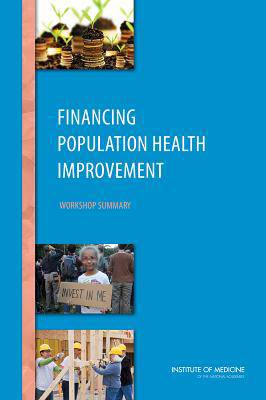
- Afhalen na 1 uur in een winkel met voorraad
- Gratis thuislevering in België vanaf € 30
- Ruim aanbod met 7 miljoen producten
- Afhalen na 1 uur in een winkel met voorraad
- Gratis thuislevering in België vanaf € 30
- Ruim aanbod met 7 miljoen producten
Financing Population Health Improvement
Workshop Summary
Institute of Medicine, Board on Population Health and Public Health Practice, Roundtable on Population Health ImprovementOmschrijving
Despite spending far more on medical care than any other nation and despite having seen a century of unparalleled improvement in population health and longevity, the United States has fallen behind many of its global counterparts and competitors in such health outcomes as overall life expectancy and rates of preventable diseases and injuries. A fundamental but often overlooked driver of the imbalance between spending and outcomes is the nation\'s inadequate investment in non-clinical strategies that promote health and prevent disease and injury population-wide, strategies that fall under the rubric of "population health." Given that it is unlikely that government funding for governmental public health agencies, whether at the local, state, or federal levels, will see significant and sustained increases, there is interest in finding creative sources of funding for initiatives to improve population health, both through the work of public health agencies and through the contributions of other sectors, including nonhealth entities.
Financing Population Health Improvement is the summary of a workshop convened by the Institute of Medicine Roundtable on Population Health Improvement in February 2014 to explore the range of resources that might be available to provide a secure funding stream for non-clinical actions to enhance health. Presenters and participants discussed the range of potential resources (e.g., financial, human, and community) explored topics related to financial resources. This report discusses return on investment, the value of investing in population-based interventions, and possible sources of funding to improve population health.
Specificaties
Betrokkenen
- Auteur(s):
- Uitgeverij:
Inhoud
- Aantal bladzijden:
- 84
- Taal:
- Engels
Eigenschappen
- Productcode (EAN):
- 9780309307468
- Verschijningsdatum:
- 20/01/2015
- Uitvoering:
- Paperback
- Formaat:
- Trade paperback (VS)
- Afmetingen:
- 150 mm x 221 mm
- Gewicht:
- 158 g

Alleen bij Standaard Boekhandel
Beoordelingen
We publiceren alleen reviews die voldoen aan de voorwaarden voor reviews. Bekijk onze voorwaarden voor reviews.











